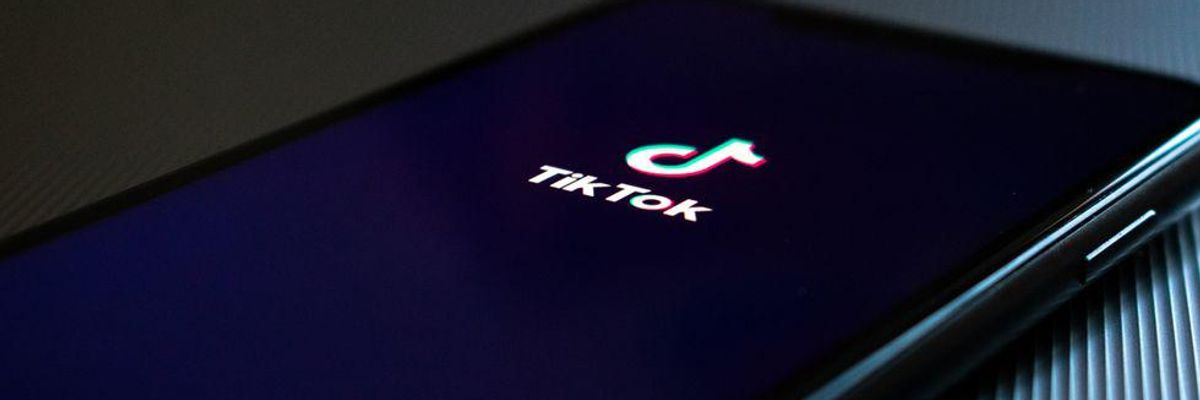

Get in the KNOW
on LA Startups & Tech
X
Trump Gives TikTok and Oracle Deal His ‘Blessing'
Gen Z Is Turning to TikTok as Go-To Search Engine, Claims Google
Kristin Snyder
Kristin Snyder is dot.LA's 2022/23 Editorial Fellow. She previously interned with Tiger Oak Media and led the arts section for UCLA's Daily Bruin.
TikTok has already dominated the social media landscape. Now, its users are helping it become a search engine.
While at Fortune’s Brainstorm Tech conference, Google Senior Vice President Prabhakar Raghavan said internal research indicates that users aged 18 to 24 are forgoing Google Search or Maps and instead sending their inquiries to social media sites. Despite growing concern about misinformation on such platforms, TechCrunch reported that TikTok and Instagram are now steering attention away from the core feature that launched the company into notoriety.
“We keep learning, over and over again, that new internet users don’t have the expectations and the mindset that we have become accustomed to,” Raghavan said at the conference.
Google, for its part, wants to highlight TikTok and Instagram videos in its search engine. Additionally, Raghavan said the search engine is incorporating more visuals while also leaning into voice searches.
As TikTok users film their meals and often add short, quippy reviews, Raghavan said Gen Z is turning to social media apps for their next lunch spot. Many TikTok users turn to influencers for food suggestions, with Los Angeles restaurants like The Red Chickz and Paris Tokyo gaining notoriety on the app.
Users often check the app for a wide range of recommendations. Raghavan’s statements confirm that TikTok users are turning to the video-sharing app for information. Videos under the hashtag for facts, hacks and recommendations, #tiktoktaughtme, have gained a cumulative 8 billion views.
Influencers on TikTok, however, often do not accurately disclose when a video includes sponsored content, as required by the Federal Trade Commission. And marketing companies have shifted to incorporate ideologies, like Urban Legend, an ad-tech startup that recruits social media celebrities from macro to nano to create content around everything from climate change to discouraging mask mandates. Urban Legend’s strategy draws on the idea that users who turn to influencers for recipe recommendations or fashion trends may also trust their opinion on political issues—even if many of the posts were not flagged as sponsored.
TikTok has also come under fire for misinformation—from the potentially harmful abortion tips to international elections to Russia’s invasion of Ukraine, the app has been criticized for not doing enough to combat it. Google has also been criticized for how its algorithm can highlight misinformation, such as suggesting “fake” abortion clinics.
With TikTok’s growing popularity, Google must contend with how to capture Gen Z’s attention as they try to retain that audience. And TikTok, for all its problems, has helped communities come together to inform people about topics ranging from autism diagnoses for women to astrological terms to LGBTQ+ information. Suggestions get local, too, with Los Angeles residents sharing free things to do downtown, vintage stores to shop at and museums to visit—succinctly providing recommendations with flashy videos.
From Your Site Articles
- Can Streaming Compete With Gaming For Gen Z's Attention? - dot.LA ›
- Poparazzi Photo App Wants To Win Over Gen Z Without Selfies - dot ... ›
- TikTok Trends: LA Urban Activists Take to Short Form Video - dot.LA ›
- How The Red Chickz Is Using TikTok To Attract Customers - dot.LA ›
- TikTok Now Aims to Make the App a Social Media Platform - dot.LA ›
- TikTok Now Aims to Make the App a Social Media Platform - dot.LA ›
- How to Game TikTok's Algorithm - dot.LA ›
- Influencers Are Convincing Gen Z To Fight Climate Change - dot.LA ›
- Social Media Algorithms May Be Annoying, But We Can't Quit - dot.LA ›
- Why Snap Wants To Implement an AI Powered Search Engine - dot.LA ›
Related Articles Around the Web
Kristin Snyder is dot.LA's 2022/23 Editorial Fellow. She previously interned with Tiger Oak Media and led the arts section for UCLA's Daily Bruin.
https://twitter.com/ksnyder_db
Struck Capital Launches a $15M Fund To Create In-House Startups
12:37 PM | July 27, 2022
Image courtesy of Shutterstock
Santa Monica-based venture capital firm Struck Capital is “flipping the traditional venture model” on its head with the launch of Struck Studio. The new company will develop startup concepts from scratch and recruit founders to lead them.
On Tuesday, Struck Capital announced the closing of a $15 million funding round to fuel 15 startup concepts over the next three years. The round was backed by investors like AOL founder Steve Case’s Revolution Ventures, US Venture Partners, Joe Montana’s Fund Liquid2, Synergis, and venture capitalists including Forever 21 founder Alex Oak and Mike Hurst.
“We fundamentally believe right now that just the way the market is, it’s harder than ever to start companies,” CEO Adam Struck said. “VCs are generally flocking to what they consider very high-quality opportunities, and the bar is much higher than it was last year to raise a seed round.”
Struck and his colleagues–CTO and co-founder of Resy Michael Montero and Tom Ryan, CEO of streaming at Paramount–wanted to create a company for risk-averse executives. In Struck’s view, these executives present the profiles they are looking for in a founder. In return, his company will offer them 50% of the startup.

Struck said the Studio currently has five ideas in product development, and the team is constantly brainstorming future concepts. So far, three startup concepts have been green-lit. One is building solutions for home subscription rental services for digital nomads; another allows Web2 developers to interact with Web3 and blockchain technologies; and another will provide vet recommendations for pets.
Once a concept goes through the validation process and enters its product development stage, the time frame takes eight weeks to complete. During this period, Struck and his team will turn to their “founder funnel,” a vetted list of candidates will be added to its network and organized based on what sector they come from.
“You kind of have to be recruiting for founders even before you know which idea is ultimately going to be spun out,” Struck said.
While the company is based in Santa Monica, Struck said they are not limiting their pool of applicants to those that live here.
Struck’s team of 19 is currently distributed across the U.S. He claims they have put together a team like the Avengers because he believes his colleagues' combined experiences are Struck Studio's superpower.
He also added that the Studio’s goal is finding signs of product market fit. Once the ideal customer profile and buyer persona are identified, Struck said there is an excellent opportunity to go to vetted founders and offer to take the reins of the startup.
“We are huge supporters of the L.A. ecosystem. And we have a natural bias for building companies in L.A.,” Struck told dot.LA, “but if we find an incredible founder and they're not in L.A., we're still gonna go with that because we think that gives the company the best chance of success.”
This story has been updated to correct Struck Studio Chairman Tom Ryan's title at Paramount.
From Your Site Articles
- These Are LA's Top Venture Capitalists of 2022, According to Their ... ›
- MaC Venture Capital Raises $203M Second Fund - dot.LA ›
- LA's Top Venture Capitalists of 2022 - dot.LA ›
Related Articles Around the Web
Read more
Show less
Decerry Donato is a reporter at dot.LA. Prior to that, she was an editorial fellow at the company. Decerry received her bachelor's degree in literary journalism from the University of California, Irvine. She continues to write stories to inform the community about issues or events that take place in the L.A. area. On the weekends, she can be found hiking in the Angeles National forest or sifting through racks at your local thrift store.
Disney Picks AI, Paramount Picks a Fight
10:30 AM | December 12, 2025
🔦 Spotlight
Happy Friday, Los Angeles.
If last week felt like Netflix bought the script for Hollywood’s future, this week Disney and Paramount walked in with rewrites. One is handing its most valuable characters to an AI model. The other is trying to yank Warner Bros. away from Netflix with an all cash offer. Underneath both headlines is the same fight over who really owns the audience.
Disney, OpenAI and the AI powered vault
The Walt Disney Company struck a multiyear agreement with OpenAI that turns Sora into a kind of licensed imagination engine for more than 200 characters across Disney, Marvel, Pixar and Star Wars. Fans will be able to generate short, Sora made videos and images featuring Mickey, Moana, Darth Vader and others, with Disney curating select clips onto Disney Plus, while ChatGPT also rolls out inside the company.
For a studio that has spent years guarding its IP with lawyers, this is a big tone shift. Disney is telling the next generation of fans that playing with the characters happens through an AI model, not just a camera or sketchbook. That could create new formats and jobs, but it also blurs the line between human made and machine made work and puts fresh pressure on ongoing union conversations about training data, credits and compensation.
Paramount crashes the Netflix and Warner Bros. story arc
On the deal side, Warner Bros. Discovery is suddenly the lead in a love triangle. After Netflix announced plans to buy WBD’s studios and streaming business for a mix of cash and stock, Paramount Skydance came in with a hostile, all cash tender offer at 30 dollars per share for the entire company, including linear networks like CNN, TNT Sports and Discovery.
So WBD investors are looking at two very different futures. A Netflix deal would bolt Warner’s IP and production engine onto the world’s largest streaming platform and strip away cable. A Paramount deal would fuse two legacy Hollywood houses and keep more of the old bundle intact. For creators and crews in LA, both paths point to the same reality: fewer, bigger buyers with more control over what gets made, how it is distributed and who gets paid.
Taken together, Disney’s OpenAI partnership and the escalating fight over Warner Bros. are not just AI news or M&A news. They are signals that the next version of Hollywood will be built by a tight circle of platforms that own the IP, the channels and now the models that sit between creators and audiences.
Now keep scrolling for this week’s LA venture deals, fund announcements and acquisitions.
🤝 Venture Deals
LA Companies
- K2 Space, a Torrance-based startup building large, high-power satellite platforms, raised a $250M Series C at a $3B valuation in a round led by Redpoint with participation from T. Rowe Price–advised accounts, Hedosophia, Altimeter, Lightspeed and Alpine Space Ventures. The company says the funding will accelerate deployment of its next generation “heavy-lift era” spacecraft, built to deliver far more power and capability than typical smallsats and to support missions across LEO, MEO and GEO for commercial and U.S. government customers, where it already has over $500M in signed contracts. - learn more
- Stic raised a $10M bridge round led by Accretion Capital, bringing the Los Angeles based out of home adtech startup’s valuation to $200M. The company, which turns everyday drivers into mobile ad inventory for brands, plans to use the funding to expand across more than 30 U.S. states and Canada, deepen relationships with national advertisers and agencies, and strengthen its operations in new markets. - learn more
- Machina Labs secured a strategic investment and initial partnership agreement from Abu Dhabi’s Strategic Development Fund, the investment arm of EDGE Group, as part of a plan to deploy its AI driven robotic manufacturing technology in the UAE. The deal includes an initial capital infusion with potential funding of up to AED 125 million as the parties explore a joint venture to produce advanced metal structures for sectors like aerospace, defense, and mobility. Machina Labs’ software defined RoboCraftsman platform will anchor the collaboration, enabling rapid, flexible production of complex metal components closer to regional demand. - learn more
- AnySignal raised a $24M Series A led by Upfront Ventures, with participation from Also Capital, BlueYard Capital, Balerion Space Ventures, First In Ventures and other strategic backers. The Los Angeles based company plans to use the funding to scale production of its space communications and RF systems, expand its national security product lines, and build a new LA area facility that brings everything from algorithm design to high rate manufacturing under one roof. - learn more
- Saviynt raised a $700M Series B growth round at an approximately $3B valuation, in a financing led by KKR with participation from Sixth Street Growth, Ten Eleven, and existing backer Carrick Capital Partners. The Los Angeles based identity security company says it will use the capital to accelerate product development and integrations as enterprises lean on its AI powered platform to govern human, machine, and AI agent identities across applications, data, and infrastructure. - learn more
- Haven Energy raised $40M in new funding to accelerate its push into distributed residential power, combining an equity round led by Giant Ventures with a debt facility from Turtle Hill and additional backing from investors including the California Infrastructure Bank, Carnrite Ventures, Chaac Ventures, Comcast Ventures, and Lerer Hippeau. The Los Angeles based company plans to use the capital to deepen partnerships with utilities and community choice aggregators, expand its solar plus battery leasing model and Channel Partner Program for local installers, and scale one of the nation’s largest residential virtual power plant networks, building on more than 10 MW installed and over 50 MW in development for 2026. - learn more
- Diald AI raised $3.75M in funding to expand its AI powered real estate due diligence and underwriting platform for investors and lenders. The company says it will use the capital to deepen its data coverage, enhance underwriting automation, and grow its customer base of institutional and private real estate investors looking to analyze deals faster and with more consistency across markets. - learn more
- Hot Smart Rich, Maggie Sellers Reum’s fast growing “female ambition” media brand, has secured a seven figure strategic investment from Steven Bartlett’s media and investment company FlightStory. The partnership aims to turn HSR into a transatlantic platform that connects culture, content, capital, and community, with ambitions to 10x revenue and headcount across production, marketing, product, ecommerce, and membership. In under a year, Hot Smart Rich has already built a cult following with around 1.8M downloads and roughly 500,000 audience members by blending money and business talk with an intimate, group chat tone. - learn more
LA Venture Funds
- Mucker Capital backed Orion Sleep’s $18M seed round, joining investors including Browder Capital and Second Sight to support the launch of the company’s AI powered Smart Cover. The startup’s mattress cover fits over any standard bed, uses built in sensors to track heart rate, breathing and sleep stages, and automatically heats or cools each side of the bed to optimize deep and REM sleep. Orion says the funding will help scale production and commercialization of its system, which starts at $2,295 and is designed as a more accessible alternative to fully replacing a mattress. - learn more
- B Capital led Fervo Energy’s oversubscribed $462M Series E, backing the Houston based company’s push to make next generation geothermal a core source of always on, carbon free power. Fervo says the round will accelerate buildout of its flagship Cape Station project in Utah, expected to reach 500 MW by 2028, and support early development of additional plants as rising AI and electrification demand strain the grid. - learn more
- Trousdale Ventures joined Vatn Systems’ $60M Series A, a round led by BVVC that the Rhode Island based defense tech company says is one of the largest financings in the autonomous underwater vehicle space. Vatn plans to use the capital to expand its team, accelerate R&D, and scale manufacturing of its Skelmir AUV platforms and INStinct navigation system as it deepens work with the U.S. Navy and Marine Corps and grows its international customer base. - learn more
- Morpheus Ventures participated in Nu Quantum’s $60M Series A, an oversubscribed round led by National Grid Partners with Gresham House Ventures also joining to back the company’s distributed quantum networking platform. Nu Quantum says it will use the capital to accelerate its “Entanglement Fabric” roadmap, scale its team, and expand globally as it connects multiple quantum processors into a modular, fault tolerant “quantum datacenter” architecture. - learn more
- Morpheus Ventures joined Fresco’s €15M Series C round, backing the company’s push to power AI driven cooking experiences across a growing network of connected kitchen appliances. The round, which also included new and existing investors like Middleby, ACT Venture Capital, AE Ventures and Alsop Louie Partners, will help Fresco scale its AI Cooking Companion and KitchenOS platform globally, integrate more OEM partners, and deliver personalized, cross brand cooking guidance to home cooks. - learn more
- Rainfall Ventures participated in Zed’s $16.5M Series A, a round led by Accel that brings the company’s total funding to $22.5M. The husband and wife founded fintech, is building a digital bank for young professionals across Asia, and plans to use the new capital to expand its APAC footprint, grow its team in San Francisco and Manila, and deepen its AI driven underwriting and credit products for this demographic. - learn more
- GroundForce Capital invested in RTZN Brands, the company behind Righteous Felon, to help scale its cleaner, craft-first jerky and meat snack portfolio. The funding follows a year of triple digit sales growth and expanding national distribution, and will support broader retail rollout, deeper club and grocery partnerships, and new high protein, clean ingredient products as Righteous Felon pushes to become a defining brand in the better for you meat snack category. - learn more
- Amplify.la participated in Pryzm’s $12.2M seed round, which was led by Andreessen Horowitz’s American Dynamism fund with additional backing from XYZ Venture Capital and Forum Ventures. Pryzm is building an AI powered operating system for federal procurement that helps government agencies discover, evaluate, and acquire emerging technology faster, while giving contractors a unified view of opportunities and capture workflows. The company plans to use the funding to scale its platform across more defense and civilian agencies and grow its team in key hubs like Washington, D.C., Boston, and New York. - learn more
- Saban Ventures joined Lin Health’s $11M oversubscribed Series A, backing the company’s virtual, neuroscience based chronic pain recovery platform alongside lead investor Proofpoint Capital and other new and existing backers. Lin Health plans to use the funding to advance product innovation, strengthen partnerships with major health systems and payers, and expand nationwide access to its non opioid, physician led and coach supported programs for conditions like migraines, IBS, and back and joint pain. - learn more
LA Exits
- tvScientific is being acquired by Pinterest, which has entered into a definitive agreement to buy the connected TV performance advertising platform as it pushes deeper into CTV. Pinterest plans to integrate tvScientific’s outcome based CTV buying, automation and attribution tools into its Performance+ and other AI powered ad products, giving advertisers a clearer view of how connected TV contributes to performance campaigns. The deal, which is subject to regulatory review and expected to close in the first half of 2026, will see tvScientific continue operating under its own brand while tapping Pinterest’s intent rich audience data across 600 million monthly users. - learn more
- VuePlanner has been acquired by Cadent, which is folding the YouTube ad planning and measurement startup into its predictive advertising platform to strengthen what it calls a “Total Video” strategy across linear TV, CTV, and YouTube. The deal gives Cadent’s clients access to VuePlanner’s AI and expert curated tools for contextual targeting, quality scoring, and independent measurement on YouTube, so advertisers can plan and activate campaigns across premium creator content and traditional TV from a single, end to end workflow. - learn more
- Cinapse is being acquired by Wrapbook and will join the film and TV payroll and production accounting platform to create a more “connected back office” that links scheduling, payroll, and accounts payable in one system. The deal brings Cinapse’s modern, cloud based scheduling tools and track record across more than $6 billion in productions into Wrapbook’s financial infrastructure, with the goal of giving producers, ADs, and studios a unified way to plan shoots and track every dollar from schedule to spend. - learn more
Read more
Show less
RELATEDTRENDING
LA TECH JOBS


